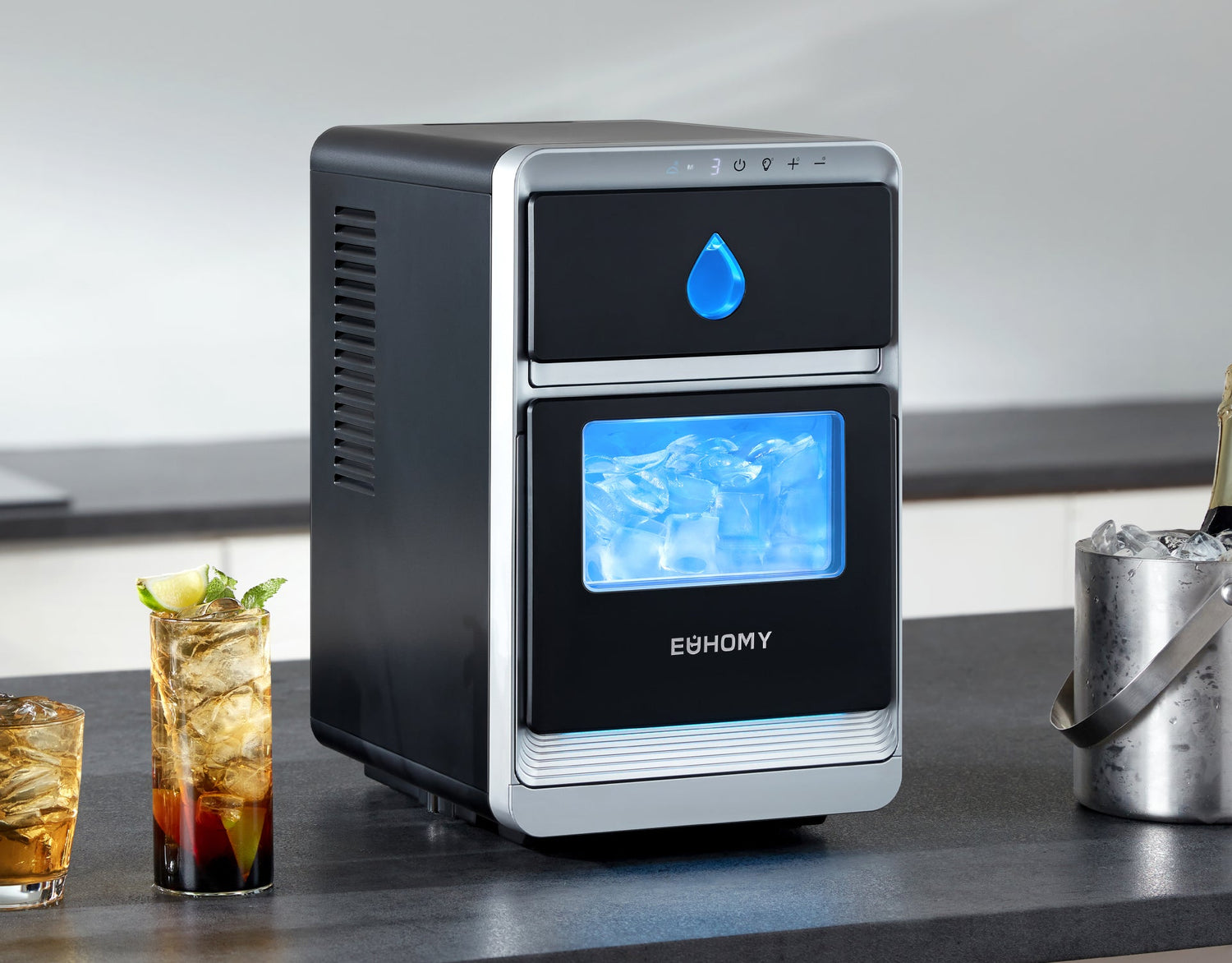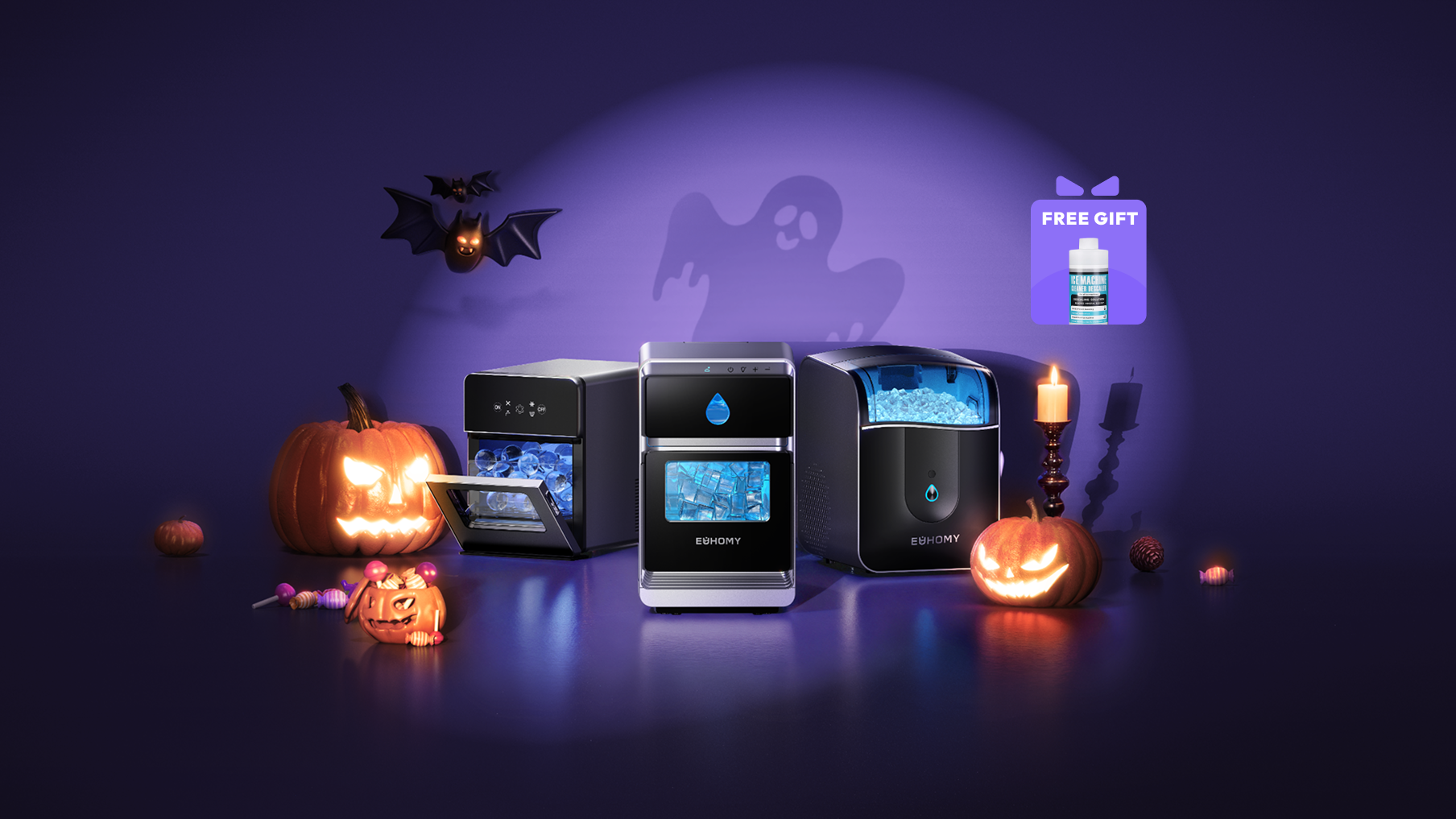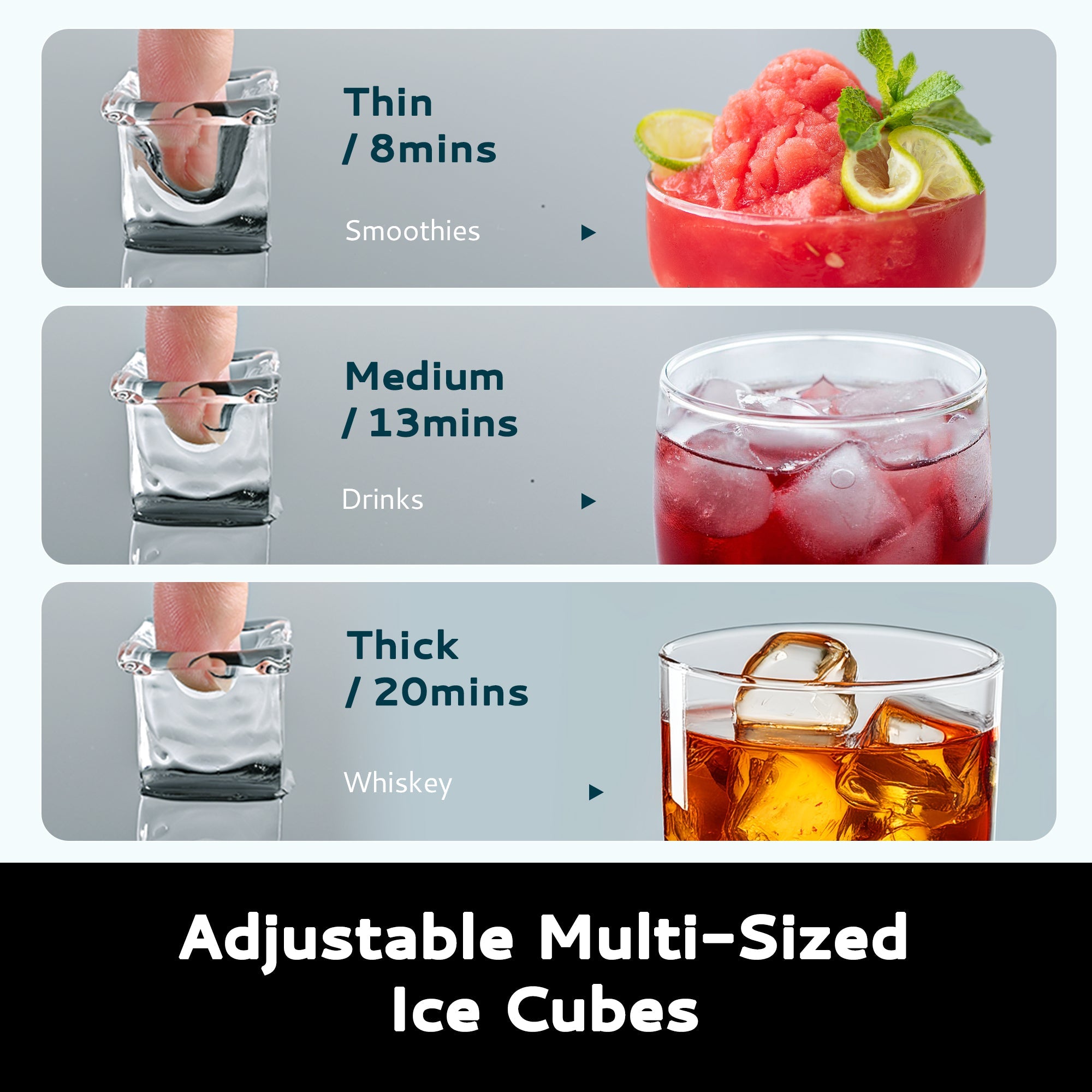Guests ask for refills, and the cooler turns slushy while trays freeze at a crawl. Drinks lose their edge, and you keep running back to the freezer. A dedicated ice maker fixes the bottleneck. Pick a unit that fits your space, choose the ice that matches your drinks, and set a simple care routine. With the right plan, every glass stays cold, clean, and consistent from the first pour to the last refill.
Understanding Different Types of Ice Makers
Choosing gets easier when you think through placement, water handling, and daily pace. Room layout and drainage influence convenience as much as capacity. Once those basics are clear, compare stated daily output on your shortlist and see how it lines up with your busiest days.
Countertop and Portable
These units plug into a wall outlet, take drinking or filtered water from a reservoir, and start producing within minutes. A countertop ice maker suits apartments, offices, and bar carts where plumbing is off limits. You can move it to the patio for a backyard gathering or pack it into an RV for weekend trips. First cycles are usually smaller while the system cools, then the output steadily. Many owners keep a scoop and a small freezer container nearby to build a reserve before guests arrive.
- Place the cabinet on a level, ventilated surface.
- Keep the lid closed during cycles to protect efficiency.
- Empty meltwater after events, then dry the bin to prevent odors.

Undercounter and Built-in
This integrated option gives a clean, permanent look in a kitchen or bar. An under counter ice maker typically needs a cold-water line, a drain, and ventilation clearances around the enclosure. Level the cabinet and confirm the door closes smoothly to minimize vibration and heat build-up. Most built-ins rely on gravity drainage, so plan the route and slope before installation and confirm the drain height relative to the outlet.
- Measure the cutout and leave airflow space at the sides and rear.
- Add a reachable shutoff valve for service.
- Run a few harvests with the door closed to verify stable output.

Freestanding and Commercial
When demand is steady and daytime peaks are common, a commercial ice maker offers higher daily output and sturdier bins. Offices, small cafés, and busy home bars lean on this category. Confirm electrical capacity, leave service access, and verify the drain's path. If the drain must rise, you may need a compatible pump; plan this before the cabinet is set.
- Protect the intake grille from dust and lint.
- Keep a clear path to the drain to avoid standing water.
- Log the first hour's cycles to learn the unit's normal rhythm.

Ice Types Explained: Nugget, Bullet, Crescent & Sphere
Ice is an ingredient. Texture, clarity, and melt rate change flavor, aroma, and mouthfeel. Pick a style that suits the glasses you serve most, then match a machine that specializes in that shape.
Nugget
Soft, airy, and easy to chew. A nugget ice maker produces small, porous pieces that pack tightly and absorb flavor, which keeps sodas, iced coffee, lemonade, and mocktails bright and refreshing. The increased surface area chills fast and feels light on the palate. People love the gentle crunch, and refills stay lively without watering down the drink too quickly. If hydration is a daily goal at home or in the office, nugget texture makes frequent refills more enjoyable.
Bullet
Rounded pieces that form quickly and slide into water bottles and tumblers. Bullet ice shines in casual settings, tailgates, and compact kitchens where speed and convenience matter. Because the pieces eject cleanly and harvest predictably, the bullet works well when you move a portable ice maker between rooms or bring it out only when company arrives. The texture is firm enough for smoothies and shaker drinks yet friendly for everyday sips.
Crescent
Half-moon pieces stack neatly, resist clumping in the bin, and look clear in tall glasses. The slower melt curve maintains balance in highballs and spritzers. Crescent fits bar carts and family dinners where presentation in glassware matters and dilution needs to be predictable. If you often pour long drinks with sparkling water or tonic, crescent pieces keep the look tidy while preserving flavor through the whole glass.
Sphere
Large spheres reduce surface exchange, which slows the melt and preserves the aroma in lowball glasses. Presentation is part of the appeal. A sphere ice maker produces bar-style pieces without molds, perfect for stirred cocktails and neat pours. If you enjoy whiskey or spirit-forward drinks, spheres keep the temperature steady while flavor unfolds in the glass.
Clear Cubes
Classic and versatile. Clear cubes chill pitchers, shaken drinks, and iced tea while keeping flavors crisp. They stack well, scoop easily, and make batch service simple for families that host regularly. For coffee and tea drinkers, clear cubes keep aroma intact and avoid cloudy "off" notes when the recipe calls for a clean finish.

Key Features to Look For When Buying an Ice Maker
Features that protect taste and trim effort pay off every week. Use this section to build a shortlist that fits your habits and space.
Cleaning and Water Management
A self-cleaning cycle keeps the water path fresh and reduces mineral buildup. Clear instructions and a reliable rinse routine make upkeep simple. Designs that recirculate meltwater stretch each fill and help the machine maintain pace during busy stretches.
- Set a weekly rinse and quick self-clean.
- In hard-water regions, plan periodic descaling.
- Removable bins and smooth liners make wipe-downs faster.
Controls and Alerts
Readable icons and direct buttons reduce guesswork. "Add Water" and "Ice Full" indicators are essential. Some models add app status checks and reminders, which help when you are hosting and away from the counter. If the unit sits in a shared space, clear signals prevent dry runs and overflows.
Performance and Noise
Check the first-batch expectation, typical cycle time, and stated daily output. Quieter systems suit open kitchens and offices. Efficient refrigeration keeps output stable as the room temperature rises in the afternoon. If your home is warm, place the cabinet out of direct sunlight and give the intake grille breathing room.
Capacity and Bin Design
Daily pounds reflect the long-run pace, while bin size shapes how often you scoop. If you entertain, you may transfer fresh ice to a freezer container to build a reserve before guests arrive. A viewing window or interior light helps you plan refills without opening the lid mid-cycle.
Build, Certification, and Support
Solid hinges, smooth interiors, and accessible panels make ownership easier. For work settings, certifications on the spec page matter. Warranty terms and responsive help reduce downtime if something needs attention. If you want the best ice maker for long-term use, check service access and parts availability before you order.

Installation, Setup, and Daily Operation Guide
A careful first day pays you back with steady output and clean taste. Walk through space, water, and power checks before you unbox.
Countertop Setup
Place the machine on a level surface near an outlet. Rinse the reservoir, fill with drinking or filtered water, and power on. Keep the lid closed while it cycles. Expect a small, irregular first harvest; production smooths as the system reaches its stride. If you need extra stock, move early batches to a freezer container so the bin stays clear for continuous harvest.
- Avoid cramped corners that trap heat.
- Use cool water to shorten the time to first pour.
- Dry the bin after events to prevent lingering smells.
Undercounter Checklist
Measure the cutout and confirm ventilation clearances. Connect the water line and route the drain with a gentle slope. Many built-ins rely on gravity drainage, so verify height to the outlet and keep the path free of kinks. Level the cabinet, confirm a clean door seal, and run several harvests with the door closed to validate performance.
- Install a reachable shutoff valve for quick service.
- Protect the drain route from foot traffic and pinches.
- Note cycle timing during the first hour for future reference.
Daily Operation Habits
Top up with fresh water at the start of the day. If pieces look cloudy, run a rinse and switch to filtered water. Dust the intake grille to preserve airflow. These small habits keep the taste consistent and harvest quick with any ice maker you choose.

Getting Started & Maintaining Your New Ice Maker
A light routine preserves flavor and extends service life. Tie tasks to your weekly cleaning so they never pile up.
Weekly Routine
Power off, drain the reservoir, and run the built-in self-clean with a measured cleaner or a food-safe solution. Rinse until any scent is gone. Wipe the bin and the scoop, then let surfaces dry before closing. Clean the gasket and corners where moisture lingers, and check sensor lenses so "Ice Full" and "Add Water" stay accurate.
Deep Clean and Descale
Mineral deposits reduce heat transfer and can dull flavor. Follow the manual for descaling frequency in hard-water regions. Unplug, drain fully, apply the descaling solution, run the recommended cycle, and flush several times with clean water. If flakes appear in early batches after a deep clean, discard them and continue rinsing until the water path is clear.
Water Quality and Filtration
Filtered or bottled drinking water improves clarity and mouthfeel. If white film appears in parts, that is a cue to descale sooner. Keep a simple log for filter changes and cleaning dates so intervals stay consistent. For office use, label the reservoir with the last cleaning date so everyone can check at a glance.
Seasonal Storage and Restart
If you pause for a month or more, drain lines and bins, dry interior surfaces, and store with the lid slightly open. On restart, run a full clean, rinse thoroughly, and discard the first tray so only fresh pieces reach glasses. In vacation homes, a quick status checklist on the inside of the cabinet door helps you remember the steps.
Quick Fixes
Slow production often traces to warm room air, dusty vents, or stale water. Improve airflow, refresh the reservoir, and give the unit a brief rest. If shapes look hollow, chill the intake water and verify the cabinet is level. Most machines bounce back once the temperature and water quality are in range.
Choosing the Right Ice Maker for Your Lifestyle
Match the unit to how you serve drinks, then confirm the daily pounds you really need. Use the table to cross-check your scenario with ice style, placement, and setup notes.
Pick by Capacity and Pace
Singles and couples do well with compact countertop models for daily hydration and evening refills. Families who host two Saturdays a month benefit from a larger bin or a built-in that refills steadily while guests mingle. Offices and cafés should plan for daytime peaks and faster harvests from a commercial ice maker that is easy to service.
Pick by Ice Type
Soft, chewable nuggets suit sodas and all-day water bottles. Clear cubes keep coffee, tea, and shaken drinks bright. Crescent keeps tall glasses tidy for mixed pours. Spheres fit slow sips in lowballs. Choose your ice style first, then filter models by that output from a nugget ice maker or other specialized design.
Pick by Placement
If plumbing is off limits, a portable ice maker or a small counter unit is the safest call. Remodels favor built-ins since drains and power can be planned cleanly. Busy common areas benefit from a freestanding cabinet with clear service access and a drain path you can inspect quickly.
Quick Comparison Table
| Situation | Preferred ice form | Placement | Daily capacity guideline | Setup note |
|---|---|---|---|---|
|
Apartment kitchen and morning iced coffee |
Nugget or clear cube |
Countertop |
Light to moderate |
Keep a freezer container for busy days |
|
Family hosting twice a month |
Crescent or nugget |
Countertop or built-in |
Moderate |
Reserve space near outlets and traffic |
|
Dedicated home bar |
Clear cube, crescent, or sphere |
Undercounter |
Moderate to high |
Confirm gravity drain and ventilation |
|
Office beverage station |
Nugget |
Freestanding or built-in |
High daytime demand |
Check circuit and drain access |
|
RV and patio cart |
Bullet or nugget |
Countertop |
Light bursts |
Shade the unit, and use cool water |

Ready to Choose? Final Checks Before You Buy
Compare two or three candidates side by side and look at ice style, installation needs, and daily output. Confirm the drain plan if you are installing under a counter. Read the cleaning steps and see how they fit your weekly rhythm. With those boxes ticked, the best ice maker for your home will keep every glass crisp from first pour to last refill.
FAQs about Ice Maker
Q1: How many pounds of ice should I plan for a small party?
A practical planning approach is to prepare a freezer reserve and let the unit handle refills during the event. Build stock in the morning, then move fresh batches to a sealed container. This keeps the bin clear so harvests continue at a steady pace when guests arrive.
Q2: Is distilled water the best choice for clear cubes?
Drinking-quality water with modest mineral content often yields reliable harvests and good taste. Distilled water can be used in some units, yet clarity also depends on clean surfaces and steady cycles. If clarity is your goal, start with filtered water, run a cleaning cycle, and avoid opening the lid mid-cycle.
Q3: Why do some cubes look hollow or irregular?
Warm intake water, restricted airflow, or mineral buildup can change how ice forms on cold surfaces. Chill the water, dust the intake grille, and run a rinse or cleaning cycle. Level the cabinet and let it stabilize. Shape usually improves once temperature and contact surfaces are back in range.
Q4: How do I size the bin for ten guests?
Think in waves. Build early batches into a freezer container, then let the machine keep the bin topped up during the event. This approach avoids running out during peak pours and reduces compaction in the bin.
Q5: Can nugget texture vary from day to day?
Yes, texture responds to room heat, water temperature, and cycle timing. Shade the cabinet, use cool intake water, and avoid opening the lid mid-cycle. Consistent inputs lead to consistent crunch and density.
Q6: How often should I replace filters?
Follow the filter maker's month count or gallon estimate and adjust for heavy use or hard water. Track changes on a label inside the cabinet so everyone knows when the last replacement happened, especially in offices or shared spaces.
Q7: What room temperature range supports stable output?
Moderate room temperatures favor steady cycles. Keep the cabinet away from ovens and direct sunlight, and leave ventilation space around the enclosure. If production slows in the afternoon, improve airflow and refresh the water to help the system catch up.
Q8: Can I use an extension cord during outdoor events?
Use a short, grounded, properly rated cord only when a wall outlet is not reachable, and route it safely to avoid trips. For everyday use, plug directly into a wall outlet to keep voltage consistent and protect performance.





Leave a comment
All comments are moderated before being published.
This site is protected by hCaptcha and the hCaptcha Privacy Policy and Terms of Service apply.